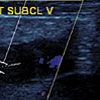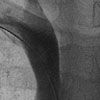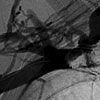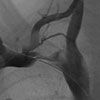Effort-Related Upper Extremity Thrombosis
During the first quarter of a football game, a 17-year-old athlete noticed that his right (dominant) arm was swollen and heavy. Two days earlier, he had fired a shotgun right-handed multiple times while hunting.

Figure 1

Figure 2

Figure 3

Figure 4

Figure 5
During the first quarter of a football game, a 17-year-old athlete noticed that his right (dominant) arm was swollen and heavy. Two days earlier, he had fired a shotgun right-handed multiple times while hunting.
The patient denied shortness of breath, chest pain, palpitations, dizziness, syncope, and mental status changes. He had no significant medical history and no family history of deep venous thrombosis (DVT). He was not taking any medications and did not smoke cigarettes or drink alcohol.
Significant nonpitting edema was present from the wrist to the shoulder. The skin was warm, capillary refill was normal, and peripheral pulses were palpable. There were no unusual venous patterns in the base of the neck or chest. Vital signs and other physical findings were normal. A complete blood cell count, serum chemistry panel, d-dimer assay, liver enzyme levels, and hypercoagulability studies were normal.
A right upper extremity ultrasonogram revealed subclavian vein thrombosis (Figure 1). A diagnosis of effort-induced axillosubclavian thrombosis was made. The cause was thought to be microtrauma from repeated strain on the shoulder that occurred as he fired his gun while hunting. The patient was given anticoagulation therapy with heparin and warfarin and was discharged.
At follow-up 10 days later, he had persistent swelling of the right arm. A venogram showed thrombosis of the proximal right axillary and subclavian veins (Figure 2). Multiple shoulder collaterals with patent brachiocephalic and internal jugular veins suggested stenosis of the right subclavian vein (Figure 3). Thrombectomy and angioplasty were performed.
A follow-up venogram revealed persistent external compression stenosis of the right subclavian vein at the clavicle-first rib junction, without evidence of a thrombus (Figure 4). The proximal left subclavian vein also demonstrated moderate stenosis with left arm elevation (Figure 5). The patient underwent a bilateral first rib resection and subclavian venolysis. After 3 months, he returned to sports activities without limitation, and warfarin was discontinued.
EFFORT-RELATED THROMBOSIS
Primary upper extremity DVT is rare (2 in 100,000 persons per year)1; it can be effort-induced (the so-called Paget-von Schrötter syndrome) or idiopathic. Paget-von Schrötter syndrome usually affects young, healthy persons with a history of repetitive arm motion, such as athletes (eg, golfers, football players, weight lifters), painters, and beauticians.2 Most cases involve the dominant arm.
MANAGEMENT
Catheter-directed thrombolytic therapy followed by surgery and decompression of the thoracic outlet is the current standard of care for patients with primary upper extremity DVT.3 If extrinsic venous compression causes Paget-von Schrötter syndrome, as in this patient, most vascular surgeons favor early anatomical correction, which may involve rib and/or clavicle resection.4
KEY POINTS FOR YOUR PRACTICE
Consider effort-related thrombosis as the cause of upper extremity DVT in young and active patients, particularly those engaged in hunting and shooting activities. An aggressive, staged, multimodal approach can effectively restore venous patency and normal flow, reduce the risk of recurrence, and return the patient to normal function.
References:
REFERENCES:
1.
Lindblad B, Tengborn L, Bergqvist D. Deep vein thrombosis of the axillary-subclavian veins: epidemiologic data, effects of different types of treatment and late sequelae.
Eur J Vasc Surg.
1988;2:161-165.
2.
Zell L, Kindermann W, Marschall F, et al. Paget-Schroetter syndrome in sports activities-case study and literature review.
Angiology
. 2001;52:337-342.
3.
Khan SN, Stansby G. Current management of Paget-Schroetter syndrome in the UK.
Ann R Coll Surg Engl
. 2004;86:29-34.
4.
Urschel HC Jr, Razzuk MA. Paget-Schroetter syndrome: what is the best management?
Ann Thorac Surg.
2000;69:1663-1669.
2 Commerce Drive
Cranbury, NJ 08512
All rights reserved.